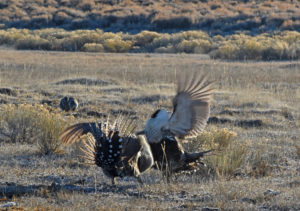For Immediate Release, March 30, 2020
Laura Cunningham, Western Watersheds Project, (775) 513-1280, lcunningham@westernwatersheds.org
Ileene Anderson, Center for Biological Diversity, (323) 490-0223, ianderson@biologicaldiversity.org
Michelle Bashin, Desert Survivors, (510) 375-4070, msbashin@gmail.com
RENO, Nev.— The U.S. Fish and Wildlife Service denied protection today to the highly imperiled bi-state sage grouse under the Endangered Species Act despite ongoing declines in the bird’s population.
The sagebrush birds’ small, isolated population straddling the Nevada and California state line continues to decline, while threats from grazing, habitat loss and mining continue. The decline is particularly acute at the northern and southern ends of the birds’ range.
“The Trump administration is ignoring the fact that these beautiful birds have been in serious trouble for more than a decade,” said Ileene Anderson, a senior scientist at the Center for Biological Diversity. “Failure to protect bi-state sage grouse is pushing them closer to population collapse. Voluntary agreements won’t save them from extinction.”
Today’s decision not to provide federal protection for the birds relies on federal land-management plans and voluntary conservation agreements with states and counties that are failing to stem the declines. The federal government’s own scientists estimate that only 3,305 bi-state sage grouse remain.
The bi-state sage grouse is a geographically isolated and genetically distinct population of the greater sage grouse. It was originally proposed for listing as threatened in 2013, but the Fish and Wildlife Service abandoned the proposal in 2015. In 2018 a federal court found the agency had wrongly denied Endangered Species Act protection to the bi-state sage grouse and required the agency to re-evaluate the bird’s situation.
“Most of the bi-state sage grouse populations are tiny, isolated groups that are under imminent threat of winking out,” said Laura Cunningham, California director of Western Watersheds Project. “Voluntary conservation projects over the past decade have been ineffective at turning around population declines, and fail to address the key threats facing this isolated population. These birds clearly need stronger legal protections.”
“It’s unconscionable that the Trump administration is abandoning this iconic bird,” said Michelle Bashin, Desert Survivors president. “These lovely birds are an integral part of the sagebrush ecosystem in the basin and range of eastern California and western Nevada that could be lost forever, making the world a poorer place for all of us.”
The Fish and Wildlife’s original listing proposal said the grouse’s small population size, inadequate protections, and multiple threats from livestock grazing, invasive plants, fire, mining and urbanization justified protection under the Endangered Species Act.
Efforts to protect the birds, including livestock fencing and vegetation-removal projects, have failed to stem population declines. Federal scientists predict localized extinctions in the north and south ends of the range. Scientists also estimate occupied habitat has decreased by more than 136,000 acres over the past 11 years.






